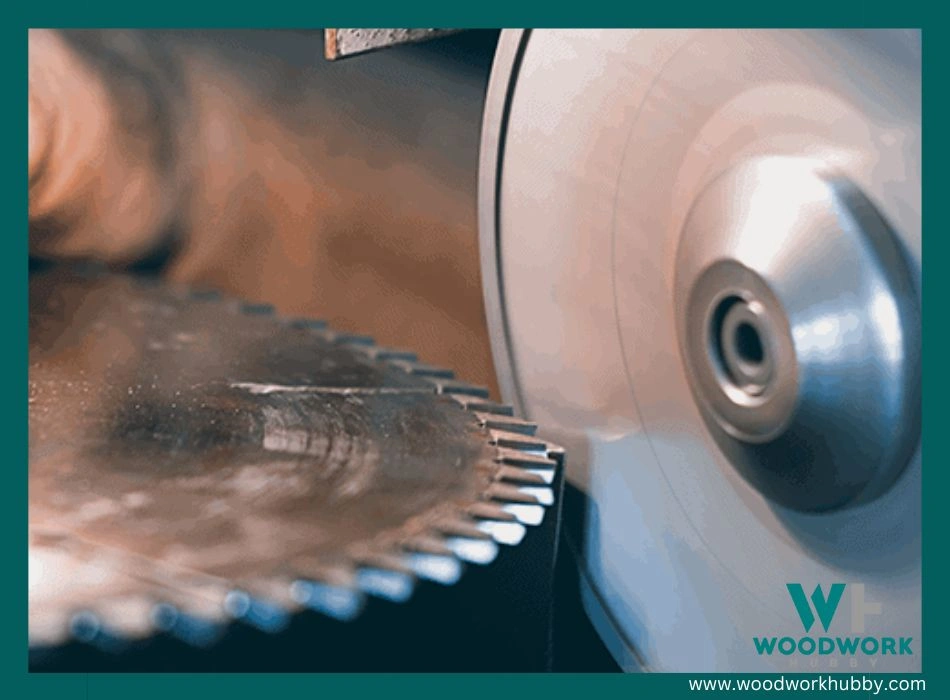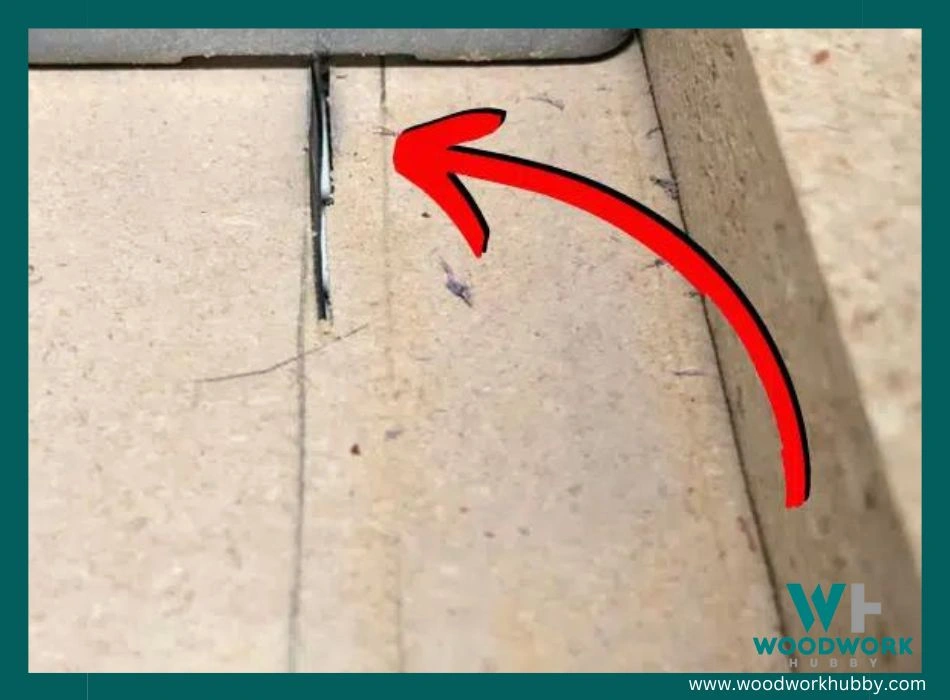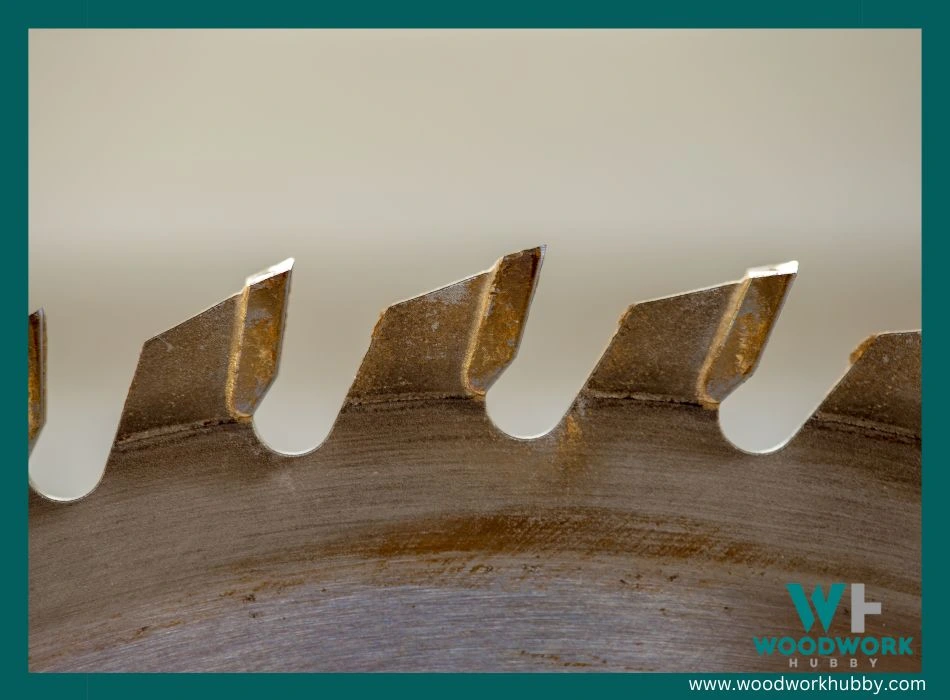Realizing that continuously replacing dull blades was running my wallet dry sparked some serious curiosity. So, I decided to test this out for myself – Can table saw blades be sharpened, and if so, how is it done?
Stick around as I untangle this debate, promising to uncover practical ways of maintaining our beloved woodworking tools for enhanced durability and performance.
Table saw blades can be sharpened either by a professional or at home with a few supplies and some care and attention.
Key Takeaways
- Table saw blades can be sharpened if the cost of sharpening is less than half the price of replacing the blade and if the blade is still in good condition.
- Signs that indicate a dull table saw blade include slower cutting, increased resistance, tear out, difficulty following a line, noise during cutting, and burn marks on the wood.
- Sharpening table saw blades requires specialized tools and experience to ensure safety and effectiveness.
- Regular maintenance such as cleaning and inspecting your table saw blades can help extend their lifespan and improve performance.
Understanding Table Saw Blades
Table saw blades are key tools for cutting wood. They come in many sizes with different numbers of teeth. The size and number of teeth a blade has will change how it cuts. Blades that have more teeth give smoother cuts but cut slower than blades with fewer teeth.
Some blades are made to cut hard things like metal or tile.
See my up-to-date and comprehensive guide on the best table saws under $1500.
Every modern table saw blade has carbide tips on the teeth. This makes the edge stay sharp longer so you can get more cuts out of it before sharpening again. But even the best blade can become dull if used a lot on tough materials or not cleaned well after use.

A dull table saw blade will give you poor results and can be very dangerous. A dull blade may cause tear out of the timber, be hard to push stock into, or leave burn marks on your wood, so knowing when and how to sharpen your table saw blades is really important!
Video on table saw blades and what to look for
Can Table Saw Blades Be Sharpened?
Table saw blades can be sharpened. Some people think they need to buy a new one when it gets dull. But that’s not true. If the blade is still in good shape and costs more than $50, it makes sense to sharpen it.
It saves money and cuts down on waste.
You don’t have to be an expert to do this job. Yet, you need some skills and special tools for sharpening your blade right. If not done correctly, you can ruin the blade and it may need to be taken to a professional.
From my experience, if a blade costs more than $50 to buy, it is worth sharpening at home. If it costs less than that, I always opt to buy a new one!

When to Sharpen a Table Saw Blade
Knowing when to sharpen your table saw blade is crucial for maintaining its performance. Signs of a dull blade include slower cuts, increased resistance, tear out, difficulty following a line, and burn marks on wood.
Video showing how to sharpen table saw blades on a table saw
If you notice any of these signs, it’s time to sharpen your blade. Keep reading to learn how to properly sharpen your table saw blade and extend its lifespan.
Video on sharpening a table saw blade
Make sure you read this article on what I consider to be the best table saws for beginners. I’m confident it will answer any of your questions.
Identifying a Dull Table Saw Blade
You can tell if your table saw blade is dull. Slow cuts are one clue. If the blade makes a lot of noise, it might be dull. The wood may burn or smoke during cutting as well. It also gets hard to follow a line when the blade is not sharp anymore.
Look for these signs to know when to sharpen your table saw blade.
See what I have discovered on the best table saws for dado cuts.
Signs That Your Table Saw Blade Needs to be Sharpened
I want to show you what a dull table saw blade looks like. Here are some signs that your table saw blade needs sharpening:

- The blade cuts slower. You will notice it takes more time than usual to cut through wood.
- There is more resistance when you push wood into the blade. It feels harder.
- Tearout happens more often. Tear out is when chunks of wood rip off instead of being cut cleanly.
- Cutting a straight line becomes tough. The saw doesn’t seem to follow your drawn line well.
- There’s extra noise when you use the saw.
- You see burn marks on your wood, or smoke comes up while cutting.
How to Sharpen Table Saw Blades?
In this section, I will guide you through the step-by-step process of sharpening your table saw blades. Don’t worry—it’s easier than you think! Keep reading to learn how to bring your dull blades back to life and save money in the process.
Safety Precautions
Before sharpening table saw blades, it’s important to take safety precautions. Here are some safety measures to follow:
- Wear the necessary safety gear, such as goggles, gloves, earplugs or earmuffs, and a dust mask respirator.
- Switch off the table saw and unplug it from the power source before starting any work to prevent accidents.
- Remove the blade from the saw before sharpening. This ensures your safety and provides easy access to the blade.
- Use specialized sharpening equipment like a grinding tool or a diamond stone. These tools are designed for proper blade sharpening.
- Follow the instructions provided with the sharpening equipment carefully to avoid any mishaps during the process.
- Clean the blade before sharpening if needed. Resins from lumber and burnt wood dust can build up on the blade, affecting its performance.
Necessary Tools
To sharpen a table saw blade, you will need the following tools:
- Specialized grinding tool
- Adjusted diamond stone or professional grinder machine
- Diamond wheel with a very fine grain (for blades with hard carbide tips)
- Good file (if sharpening by hand)
Removing the Blade
Removing the blade is an important step in sharpening your table saw blade. Here’s how to do it:
- Turn off and unplug the table saw.
- Put on personal protective equipment (PPE) like safety goggles and gloves.
- Locate the arbor nut, which holds the blade in place.
- Use a wrench to loosen and remove the arbor nut. Which way do you loosen the nut? I wrote this full article on – are table saw blades reverse threaded?
- Carefully lift the blade off of the arbor shaft.
- Place the blade on a clean and stable surface, making sure it won’t move or fall.
- If necessary, use a brush or compressed air to remove any sawdust or debris from the blade.
Sharpening Process
Sharpening table saw blades is a process that requires specific tools and steps. Here’s how it can be done:
This video is extremely helpful in showing how you can sharpen a table saw blade by hand
Video showing how to sharpen a table saw blade by hand
- Prepare the necessary safety precautions, such as wearing personal protective equipment (PPE) like safety glasses and gloves.
- Gather the required tools for sharpening, including a specialized grinding tool or diamond stone, depending on the type of blade.
- Safely remove the table saw blade from the saw, following the manufacturer’s instructions.
- Begin sharpening the teeth of the blade using the chosen method. This may involve using a specialized grinder or manually sharpening with a file or sharpening stick.
- Pay attention to maintaining consistent angles and even pressure while sharpening each tooth of the blade.
- Consider lubricating the blade periodically during the sharpening process to prevent overheating and promote smoother cutting.
- Once all teeth are sharpened, inspect for any damaged or chipped teeth that may need fixing before reinstallation.
- Reinstall the newly sharpened blade back onto the table saw, ensuring it is aligned properly and securely fastened according to manufacturer guidelines.
Lubrication and Fixing
Lubricating and fixing your table saw blade is an important step in the sharpening process. Here’s how you can do it:
- Apply lubricant: Before reinstalling the blade, apply a lubricant to reduce friction and ensure smooth cutting. This will also help prevent rusting.
- Check for any loose components: Make sure all the screws, bolts, or nuts that hold the blade in place are tightened securely. Loose components can affect the performance of the blade and compromise safety.
- Inspect for damage: Take a close look at the blade for any signs of wear or damage. If you notice any cracks, chips, or missing teeth, it may be time to replace the blade instead of sharpening it.
- Align the blade: Ensure that the blade is properly aligned with the saw’s arbor. Adjustments may be necessary to achieve precise cutting.
- Test before use: After lubrication and fixing, run a test cut on scrap wood to check if the blade performs smoothly and cuts accurately.
Reinstalling the Blade
When reinstalling the blade, it’s important to follow the manufacturer’s instructions or seek professional assistance. Here are some key points to keep in mind:
- Carefully align the blade to ensure proper cutting performance.
- Ensure that the blade is still in good condition and hasn’t been severely damaged.
- Use specialized tools or techniques if necessary.
- Reinstalling the blade can help extend its life and save money compared to replacing the entire blade.
Maintaining Your Table Saw Blades
To keep your table saw blades in good shape, regular maintenance is important. After all, a well-maintained blade can last longer and perform better. Here are some tips for maintaining your table saw blades:

Firstly, clean your blades regularly. Use a blade cleaning solution to soak the blade and then scrub it with a brush to remove any built-up resin or pitch. Rinse the blade with water and make sure it is completely dry before using it again.
Inspect your blades for any damage or dullness on the teeth. If you notice any shoulder or tip damage, it’s time to replace the blade. However, if the blade is just dull, you can consider sharpening it instead of buying a new one.
Always use high-quality blades as they tend to last longer and offer better performance. Cheaper blades may need more frequent replacements due to their lower-quality materials.
Consider getting a professional sharpening service if you’re unsure about how to properly sharpen your own blades or lack the necessary equipment. This way, you can ensure that your blades are being handled by experts who know exactly what they’re doing.
By following these maintenance tips, you can extend the lifespan of your table saw blades and avoid unnecessary expenses on replacements. Regular cleaning and inspection will help keep them in top condition for efficient wood-cutting projects.
Conclusion – Can Table Saw Blades Be Sharpened?
In conclusion, table saw blades can indeed be sharpened if the cost of sharpening is less than half the price of replacing the blade and if the blade is in good condition. It’s important to know the signs that indicate a dull blade, such as slower cutting, increased resistance, tear out, difficulty following a line, noise, and burn marks.
If you have expensive blades or specialized ones costing over $50, it’s usually worth sharpening them to reduce waste and save money in the long run. However, cheaper blades may not be worth sharpening and should be replaced when they no longer cut cleanly.
Sharpening table saw blades requires experience and specialized tools to ensure safety and effectiveness.
FAQs
1. Can dull table saw blades be sharpened or should they be replaced?
Dull table saw blades can be sharpened either by hand or with a machine at home. This will save money and reduce wastage.
2. How much does it cost to sharpen a table saw blade?
The price of re-sharpening a blade ranges between $30 – $100 depending on the type of blade and the number of teeth it has. Generally, it is cheaper than buying new blades every time, especially for high-quality carbide blades.
3. What tools do I need to sharpen my own saw blades?
You would need specialized tools like an angle grinder or diamond wheels with fine grain for hand sharpening the blade teeth. You can do them by hand with a quality file and a vice.
4. Can I practice on an old saw blade before moving on to my good ones?
Yes! Practicing on old or cheaper saw blades is a smart way to get comfortable with your sharpener before working on your high quality blades.
5. Is there anything else I can do to keep my table saw running well?
Apart from keeping the blade sharp, regularly cleaning and drying your table saw after use extends its service life and helps maintain safety in your workshop.
6. Are there services available if I don’t want to risk ruining a pricey blade by doing it myself?
Absolutely! You have various options such as hiring professional services that specialize in tool maintenance like power tool accessories and circular saw blade cleaning & resharpening.




